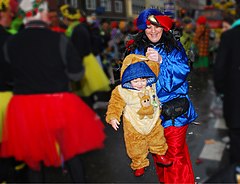Rosenmontag
Jump to navigation
Jump to search
Rosenmontag (English: Rose Monday[1]) is the highlight of the German Karneval (carnival), and takes place on the Shrove Monday before Ash Wednesday, the beginning of Lent.[2] Mardi Gras, though celebrated on Fat Tuesday, is a similar event. Rosenmontag is celebrated in German-speaking countries, including Germany, Austria, Switzerland and Belgium (Eupen, Kelmis), but most heavily in the carnival strongholds which include the Rhineland, especially in Cologne,[3] Bonn, Düsseldorf,[4] Aachen and Mainz.[5] In contrast to Germany, in Austria, the highlight of the carneval is not Rosenmontag, but Shrove Tuesday.
The name for the carnival comes from the German dialect word roose meaning "frolic" and Montag meaning Monday.[1]
The Karneval season begins at 11 minutes past the eleventh hour on 11 November and the "street carnival" starts on the Thursday before Rosenmontag, which is known as Weiberfastnacht ("women's carnival", Fat Thursday). Karneval
is prevalent in Roman Catholic areas and is a continuation of the old
Roman traditions of slaves and servants being master for a day. Karneval derives from the Latin carnem levare ("taking leave of meat") marking the beginning of Lent.[6]
| Rosenmontag | |
|---|---|

Families and children in costumes, Rosenmontag 2009 in Aachen
| |
| Significance | Highlight of Karneval before Lent |
| Date | Monday before Ash Wednesday |
| 2019 date | 4 March |
| 2020 date | 24 February |
| 2021 date | 15 February |
| 2022 date | 28 February |
| Frequency | annual |
The name for the carnival comes from the German dialect word roose meaning "frolic" and Montag meaning Monday.[1]
Overview
Carnival is not a national holiday in Germany, but schools are closed on Rosenmontag and the following Tuesday in the strongholds and many other areas. Many schools as well as companies tend to give teachers, pupils and employees the Thursday before Rosenmontag off as well and have celebrations in school or in the working place on Weiberfastnacht, although every now and then there are efforts to cut these free holidays in some companies.[citation needed]
Celebrations usually include dressing up in fancy costumes, dancing, parades, heavy drinking and general public displays with floats. Every town in the Karneval areas boasts at least one parade with floats making fun of the themes of the day.[7] Usually sweets (Kamelle) are thrown into the crowds lining the streets among cries of Helau or Alaaf, whereby the cry Kölle Alaaf is only applied in the Cologne Carnival – Alaaf stems from or Alle af, Ripuarian for "all [others] away". Sweets and tulips are thrown into the crowd.
The celebrations become quieter the next day, known as Veilchendienstag ("Violet Tuesday", Shrove Tuesday), and end with Ash Wednesday.
See also
| Wikimedia Commons has media related to Rosenmontag. |
References
- Kilb, Benjamin. "Rosenmontag". e-photoreview. Archived from the original on 8 April 2013. Retrieved 10 February 2013.